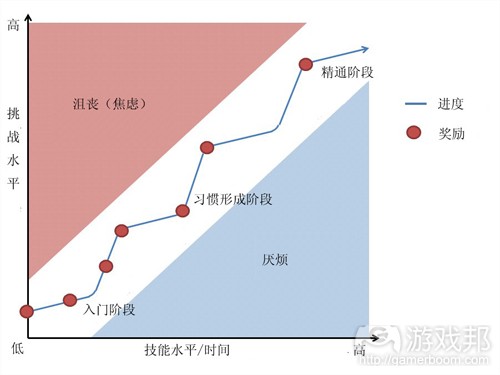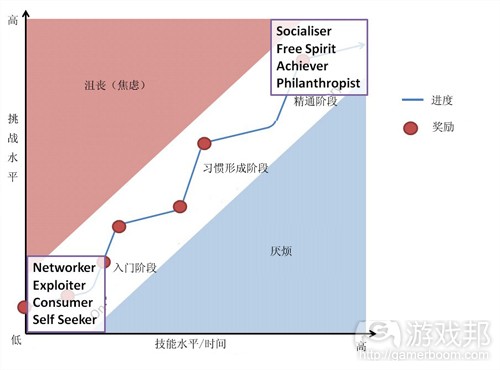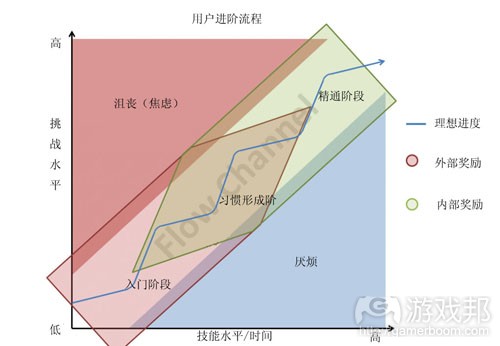阐述外在与内在动机型用户的区别
作者:Andrzej Marczewski
在本文之前,我已经详细地写了一篇关于用户类型的文章。本文说的也是用户类型,只不过这次我想从更简单的角度来解释这8种用户类型以及它们之间的转化关系。在之前的文章里,我先谈论5种类型,之后又只说了其中4种,最后又总结出8种,这让读者感到很困惑——我要说声抱歉。
我已经详细地探讨过内动机类型,所以没必要重复旧内容了。简单地说,它们分别是:
社交家(Socialiser)
自由人(Free Spirit)
成就者(Achiever)
慈善家(Philanthropist)
以上各类型的主要动机分别是关联性(Relatedness)、自主权(Autonomy)、精通(Master)和目的(Purpose)。我取这四种动机的英文首字母统称为RAMP。
外在动机型用户其实没有太大差别,只是他们的关键动机不同——他们是受奖励刺激的。
这四种外在动机类型是:
建网者(Networker)
探求者(Exploiter)
消费者(Consumer)
索取者(Self Seeker)
从名称上看,他们的角色应该就是影片中的坏人。但事实上,他们可能正是一个系统中的内在动机型用户的前身。
在一个系统中,社交者的主要动机是与人建立联系。建立联系可能带来其他东西如社会对位,但最让这类用户感兴趣的还是人。其他东西只是为了强化社交关系。建网者与社交者一样,也建立联系,但他们是为了得到奖励。
他们会创造关系,但吸引他们的不是与之产生联系的真正的人,从关系创造中能获得的东西才是他们的兴趣所在。他们的想法是,关系网越广,奖励就越大,得到奖励的机会也越多。
其他类型也是如此。
自由人希望在探索系统,并从探索中创造纯粹的乐趣,而探求者也探索,但他们是为了得到奖励。他们会搜索以找到循环的漏洞,以便自己更快获得更多好处。他们也会创造,但目标仍是奖励(游戏邦注:想一想在《第二人生》中建造房屋等然后出售给其他人的玩家)。
成就者希望从系统中获得知识。他们的目标是变得更强,提高直到精通某种能力。消费者有一点不同。他们仍然使用相同的系统,他们也确实学习和测试。但他们这么做是为了得到奖励。这里的奖励可能是奖品、可能是某种积分,甚至是谋求新工作必需的知识。二者的区别是,后者的动机不是喜欢挑战和追求精通。稍有例外的是,那些最沉浸于忠实奖励计划的人——这种计划其实并不要求你做太多事就能得到奖励。但这种类型的极端是,想成为最获得积分最多的人。
慈善家喜欢提供帮助。他们喜欢回答问题、帮助别人、调节纠纷等。索取者会做同样的事,但还是那句话,他们是为了得到奖励。他们会回答问题,但目的是得到某种能提高地位的点数。慈善家把地位当成帮助更多有需要的人找到他们的方法,以便帮助这些人;而索取者把地位当成获得奖励的途径。另外,索取者通常是那些用低劣内容充斥系统的人。如果他们要的只是奖励,且制造垃圾就能帮他们得到点数,为什么还要创造高品质的内容呢?
在开头部分我说内在动机型用户可能从外在动机型用户演变而来,但如何演变?好吧,这是一个关键问题,需要更多数据才能给出一个标准答案!基本思路是,好的系统会吸引人进入系统并引导他们达到精通。
点数和奖励是非常实用的工具。当新用户做对时,它们可以给他们有趣的信号。在入门阶段,每一个成就都是对新用户的奖励和认可。
我使用以下图表来表示这个过程。
上图表示的是用户从入门过渡到精通的“理想”奖励时间表。这个时间表的要点是,在入门阶段给大量奖励,在习惯形成阶段减少奖励,到精通阶段就完全不需要给奖励了。
为什么是这样?因为到了精通阶段,用户应该已经找到比奖励更能激励他们留在系统中的原因了。也就是说,他们应该已经找到留下的内在动机了。
为了完整,我用下图表示从外在动机向内在动机转变的理想过程。
注意
外在动机型用户并不一定会转化成对应的内在动机型用户,同样地,内在动机型用户也可能转化成其他类型的用户。也就是说,探求者可能会变成自由人!
例如,制造庞大的联系网络的建网者可能会变成慈善家,而不是社交者。取决于他们在这个系统中的发展,他们可以把帮助他们关系网内的人当作他们留下的理由。成就者或消费者也有可能转变为慈善家。一开始他们的目的是获得知识,但渐渐地把回报他人当成自己的动机。
另一点要记住的是,游戏化的系统不同于游戏。它们的设计意图是为了达到某种目的。这意味着,用户选择留在不同系统中的理由可能各不相同。进而这也意味着,相同用户可能在不同的系统中体现为不同的类型。
我写本文的目的是让人们理解他们的系统可能存在的用户类型以及其动机的多样性。我强调了四种核心动机,但还存在其他想法。我要说的重点是,人是不同的,他们做某事的理由也不同。事实上,一个用户做某事的理由通常会在使用你的系统中发生多次变化。你可能无法设计出一种满足所有用户的系统,但必须记住不同的类型,即使只是理解为什么有些人不太能接受你的游戏化系统——可能是因为这个系统并不是为他们设计的!(本文为游戏邦/gamerboom.com编译,拒绝任何不保留版权的转载,如需转载请联系:游戏邦)
Extrinsically and Intrinsically Motivated User Types
by Andrzej Marczewski
Yep, it’s User Types again. However, what I want to write about now is a simpler view of the full 8 types, why there are 8 and how they are related. There is some confusion over this as originally I published 5 types, then spoke only about 4 of them and then released 8 – so sorry about that, this is a process and sadly you are all on the ride with me!
I have written about the intrinsically motivated types at great length, so no need to cover much old ground. Briefly they are;
Socialiser
Free Spirit
Achiever
Philanthropist
Each is primarily motivated by one of the four motivators I speak about in RAMP: Relatedness, Autonomy, Master and Purpose.
The Extrinsically motivated user types (which I also call the Player user types) are not all that different, they just have one key change - they are in it for the rewards.
The four extrinsically motivated types are;
Networker
Exploiter
Consumer
Self Seeker
All very emotive names and make them out to be the bad guys of the show, but actually they are vital and are likely to be how the intrinsically motivated user types start out life in your system.
A Socialiser is in a system to create connections and meet people, that is their main motivation. With this can come other things such as social status, but it is people that interest them.
Everything else is just there to enable this. A Networker will do the same things as a Socialiser, but for reward. They will connect and talk and create relationships, but they will be more
interested in what they can gain from them, not the actual people they are connecting with. With status comes greater rewards and opportunities for rewards.
This is the same for the other types.
Free Spirits want to explore and create for the simple enjoyment that can be had from this, the Exploiter will do the same, but for reward. They will explore to find the loop holes that allow them to gain more faster. They will create, but to gain reward (think of people in Second Life who create houses and the like to sell on to others).
Achievers want to gain knowledge and understanding from a system. Their goal is to become better, to improve and strive for mastery. Consumers are a little different. They will still use the same system, they will do the learning and they will take the quizzes etc. but they will be doing it to gain something. It may be rewards, it may be frequent flyer points, it may even be to gain the knowledge they need to get a new job. The difference is they are not doing it for the love of the challenge and the quest for mastery. What makes these a slight exception is that these are the people who will be most engaged in loyalty schemes – schemes you actually don’t have to do much to get rewards from. At the extreme though, they are the sort who want to be the person with the most air miles ever!
Philanthropists like to help. They like to answer questions, to assist others, to moderate forums etc. Self Seekers will do the same, but again, for a price. They will answer questions, but to get points or some kind of increased status. Where a philanthropist sees status as a way to help more people find them so that they can help them, self seekers see status as a path to reward. The
downside of this is that self seekers are often the ones who flood systems with poor quality content. If all they want is the reward, why should they create quality content if rubbish will get them points?
I said at the beginning that intrinsic user types might evolve from extrinsic user types, but how? Well, that is a key question and one that needs much more data to give a formulaic answer too!
The basic idea is that a well designed system will introduce people to the system (on boarding) and then guide them to mastery or as Yu Kai Chou describes it “Endgame”.
Points and rewards are very useful on boarding tools. They can give a new user fun signals that they are on the right track. Each achievement is rewarded and recognised as they go through the beginning of their journey.
I used the following diagram to represent this a while back.
It shows an “ideal” reward schedule to help a user go from on boarding to mastery and beyond. The idea is to give regular rewards at first, in the habit forming phase start to slow down the rewards and by the mastery phase (the beginning of the real journey in some cases), there should be no need for rewards at all.
Why is this? Well, by then they should have found reasons beyond the rewards to be involved in the system. They should have found their intrinsic reason to stick around.
Just for completeness, here is an image that shows the ideal conversion from extrinsic to intrinsic motivations!
Some things that are important to keep in mind.
An extrinsically motivated user type is not guaranteed to convert to the mirrored intrinsic type, in the same way that in intrinsic type may not stay the same over time. So an exploiter is not predetermined to become a free spirit!
For example. A networker, who is creating a huge network of contacts for gain, could change over time into a philanthropist rather than a socialiser. Depending on what their journey is in the
system, they could decide that the reason to stay around is actually to help all of those people they are connected to. An achiever or consumer may also become a philanthropist over time. They gain knowledge initially and over time decide that they want to give some of that back to other users.
The other thing to keep in mind is that gamified systems are not the same as games. They are designed to achieve a certain purpose. This means that the reason to be involved may be different for every system a user comes into contact with. In turn this means that each user may display different user type traits system to system.
The reason I created these was to help people understand the sorts of people that may user their system and how diverse their motivations may be. I have concentrated on 4 types of core motivation, there are other ideas out there (Yu Kai Chou’s 8 core drives in Octalysis spring to mind). They key peoint to take away from this, is that people are not all the same and their reasons for doing things are not all the same. In fact, a single users reasons for doing things will often change multiple times over the course of the, using your system. You may not be able to design for all types of users, but it is important to keep them in mind even if it is just to understand why some people are not engaging with your gamified system – it may just not be designed for them!(source:gamasutra)
上一篇:阐述电子游戏UI定义及其进化之旅
下一篇:策略游戏设计所面临的7大常见问题










































 闽公网安备35020302001549号
闽公网安备35020302001549号